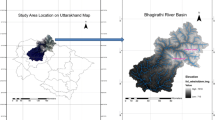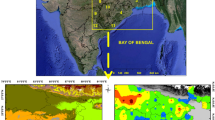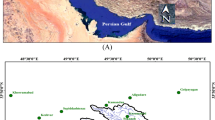Abstract
Investigation of changes in rainfall and runoff patterns in various regions and determining their relationship in the sense of hydrology and climatology are of great importance, considering those patterns efficiently reveal the human and natural factors in this variability. One of the mathematical methods to recognise and model these fluctuations is Wavelet Analysis. This is a spectral method used in multivariate analysis and also tracing fluctuations in temporal series. In this study, continuous wavelet transformation is used to identify temporal changes in rainfall–runoff patterns. The hydrological and rain gauge data were collected from in situ measurements of Kermanshah province located in the western border of Iran. Precipitation anomalies were reconsidered in a number of stations, including Kermanshah, for a period of 55 years (1955–2010) and discharge of Gamasiab River in Polchehr station, discharge of Khoram Rood River in Aran-Gharb station and discharge of Gharasoo River in Polekohne station. In addition, anomalies of the climatic teleconnections were studied to emphasise the climatological effects on the runoff pattern in the region. The role of natural and anthropogenic effects (land use changes) has been distinguished and identified, using the comparison of the teleconnections and hydrological data. The results achieved from three stations show that there was an approximate correlation between rainfall, runoff and teleconnections until the year 1995; however, after 1995, a great difference appeared among them, specifically for the Aran-Gharb station (Khoram Rood River). The post-1995 slope of cumulative standardised anomaly is much steeper in the case of runoff compared to rainfall. As there were no significant climate changes in the region, it could be concluded that the runoff decrease is not caused by climate changes, but by anthropogenic effects, human interventions and extra water usage from the surface and underground water resources for agriculture and economic purposes.







Similar content being viewed by others
References
Ångström A 1935 Teleconnections of climatic changes in present time; Geogr. Ann. 17 242–258.
Chui C K 1992 An Introduction to Wavelets, Vol. 1 of Wavelet Analysis and its Applications; Academic Press, Boston.
Clemen T 1998 The use of scale information for integrating simulation models into environmental information systems; Ecol. Model. 108 (1) 107–113.
Daubechies I 1992 Ten Lectures on Wavelets, Vol. 61 of CBMSNSF Regional Conference Series in Applied Mathematics; Society for Industrial and Applied Mathematics, Philadelphia.
Drosdowsky W 1993 An analysis of Australian seasonal rainfall anomalies: 1950–1987: II. Temporal variability and teleconnection patterns; Int. J. Climatol. 13 111–149.
Gu D and Philander S G H 1995 Secular changes of annual and interannual variability in the tropics during the past century; J. Climate 8 864–876.
Hildebrandsson H H 1897 Quelquerecherchessur les entresd’action de l’atmosphere, K. Sven. Vetenskapsakad; Handl 29 1–33.
Holschneider M 1995 Wavelets, analysis tool; Oxford Univ. Press, New York.
Kane R P 1997 On the relationship of ENSO with rainfall over different parts of Australia; Aust. Meteorol. Mag. 46 (1) 39–49.
Kim S 2004 Wavelet analysis of precipitation variability in northern California, USA; KSCE J. Civ. Eng. 8 (4) 471–477.
Kuang Z, Ji Z Z and Lin Y H 2000 Wavelet analysis of rainfall data in North China; Clim. Environ. Res. (in Chinese) 5 (3) 312–317.
Lau K M and Weng H 1995 Climate signal detection using wavelet transform: How to make a temporal series sing; Bull. Am. Meteorol. Soc. 76 (12) 2391–2402.
Liu Z and Alexander M 2007 Atmospheric bridge, oceanic tunnel, and global climatic teleconnections; Rev. Geophys. 45 (2) RG2005.
Maleky M and Razavi B S 2013 Evaluation of development and changes in land use using different satellite image processing and remote sensing techniques (Case study: Kermanshah, Iran); Res. J. Environ. Earth Sci. 5 (10) 567–576.
Meyers S D, Kelly B G and O’Brien J J 1993 An introduction to wavelet analysis in oceanography and meteorology with application to the dispersion of Yanai waves; Mon. Wea. Rev. 121 2858–2866.
Morlet J 1983 Sampling theory and wave propagation. In: Issues in Acoustic Signal/Image Processing and Recognition (ed.) Chen C H, Vol. 1 of NATO ASI Series. Springer-Verlag, New York, pp. 233–261
Nakken M 1999 Wavelet analysis of rainfall–runoff variability isolating climatic from anthropogenic patterns; Environ. Model. Softw. 14 (4) 283–295.
Nener B D, Ridsdill-Smith T A and Zeisse C 1999 Wavelet analysis of low altitude infrared transmission in the coastal environment; Infr. Phys. Technol. 40 399–409.
Nicholls N and Kariko A 1993 East Australia rainfall events: Interannual variations, trends, and relationships with the southern oscillation; J. Climate 6 1141–1152.
Ogden R T 1997 Essential Wavelets for Statistical Applications and Data Analysis; Birkhäuser, Boston.
Opoku-Ankomah Y and Cordery I 1993 Temporal variation of relations between New South Wales rainfall and the southern oscillation; Int. J. Climatol. 13 51–64.
Rajabi A and Shabanlou S 2012 Climate index changes in future by using SDSM in Kermanshah, Iran; J. Environ. Res. Dev. 7 (1).
Rasuly A A, Babaeian I, Ghaemi H and ZawarReza P 2012 Temporal series analysis of the pressure of the synoptic pattern centers affecting on seasonal precipitation of Iran; Geography and Development 10th Year (27) 18–21.
Smith N 1995 Recent hydrological changes in the Avoca River catchment, Victoria; Aust. Geogr. Stud. 33 (1) 6–18.
Stone R and Auliciems A 1992 SOI phase relationships with rainfall in eastern Australia; Int. J. Climatol. 12 625–636.
Suppiah R and Hennessy K J 1996 Trends in the intensity and frequency of heavy rainfall in tropical Australia and links with the southern oscillation; Aust. Meteorol. Mag. 45 1–17.
Walker G T 1924 Correlation in seasonal variations of weather IX, Mem; India Meteorol. Dept. 24 275–332.
Wallace J M and Gutzler D S 1981 Teleconnections in the geopotential height field during the Northern Hemisphere winter; Mon. Wea. Rev. 109 (4) 784–812.
Wang B and Wang Y 1996 Temporal structure of the southern oscillation as revealed by waveform and wavelet analysis; J. Climate 9 1586–1598.
Xu Y, Li S and Cai Y 2005 Wavelet analysis of rainfall variation in the Hebei Plain; Sci. China. Ser. D 48 (12) 2241–2250.
Zhang X-G and Casey T M 1992 Long-term variations in the southern oscillation and relationships with Australian rainfall; Aust. Meteorol. Mag. 40 (4) 211–225.
Acknowledgements
The current research project has been supported by a grant (92/130/59292) by the research committee of Kermanshah Regional Water Company. The authors appreciate the committee for the financial supports, and would also like to thank the Iranian Meteorology Organization (IRIMO) and Kermanshah Regional Water Corporation for providing the data. Finally, the authors express their gratitude to Mohammad Saeed Najafi for creating figure 7 for this research.
Author information
Authors and Affiliations
Corresponding author
Additional information
Corresponding editor: Subimal Ghosh
Rights and permissions
About this article
Cite this article
GHAFARIAN, P., GHOLAMI, S., OWLAD, E. et al. Rainfall–runoff temporal variability in Kermanshah province, Iran and distinguishing anthropogenic effects from climatic effects. J Earth Syst Sci 125, 1299–1311 (2016). https://doi.org/10.1007/s12040-016-0731-9
Received:
Revised:
Accepted:
Published:
Issue Date:
DOI: https://doi.org/10.1007/s12040-016-0731-9




